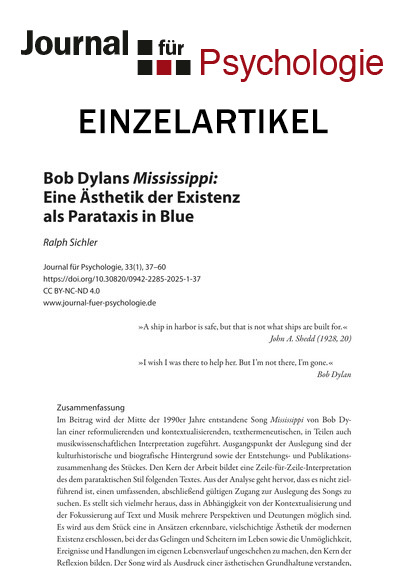Bob Dylans Mississippi: Eine Ästhetik der Existenz als Parataxis in Blue
DOI:
https://doi.org/10.30820/0942-2285-2025-1-37Schlagworte:
Kulturpsychologie, Kunst, Lebenskunst, Musikpsychologie, TexthermeneutikAbstract
Im Beitrag wird der Mitte der 1990er Jahre entstandene Song Mississippi von Bob Dylan einer reformulierenden und kontextualisierenden, texthermeneutischen, in Teilen auch musikwissenschaftlichen Interpretation zugeführt. Ausgangspunkt der Auslegung sind der kulturhistorische und biografische Hintergrund sowie der Entstehungsund Publikationszusammenhang des Stückes. Den Kern der Arbeit bildet eine Zeile-für-Zeile-Interpretation des dem parataktischen Stil folgenden Textes. Aus der Analyse geht hervor, dass es nicht zielführend ist, einen umfassenden, abschließend gültigen Zugang zur Auslegung des Songs zu suchen. Es stellt sich vielmehr heraus, dass in Abhängigkeit von der Kontextualisierung und der Fokussierung auf Text und Musik mehrere Perspektiven und Deutungen möglich sind. Es wird aus dem Stück eine in Ansätzen erkennbare, vielschichtige Ästhetik der modernen Existenz erschlossen, bei der das Gelingen und Scheitern im Leben sowie die Unmöglichkeit, Ereignisse und Handlungen im eigenen Lebensverlauf ungeschehen zu machen, den Kern der Reflexion bilden. Der Song wird als Ausdruck einer ästhetischen Grundhaltung verstanden, die sich durch die Überwindung von letzten Gewissheiten, das Akzeptieren von Ambiguität und Unvollständigkeit und der Suche nach einer zutiefst individuellen Form von reflektierter Selbstentfaltung charakterisieren lässt.
Zitationsvorschlag
Sichler, Ralph. 2025. „Bob Dylans Mississippi: Eine Ästhetik Der Existenz Als Parataxis in Blue“. Journal für Psychologie 33 (1):37-60. https://doi.org/10.30820/0942-2285-2025-1-37.
Ausgabe
Rubrik
Artikel
Lizenz

Dieses Werk steht unter der Lizenz Creative Commons Namensnennung - Nicht-kommerziell - Keine Bearbeitungen 4.0 International.
Diese Lizenz erlaubt die private Nutzung und unveränderte Weitergabe, verbietet jedoch die Bearbeitung und kommerzielle Nutzung. Weitere Informationen finden Sie unter: https://creativecommons.org/licenses/by-nc-nd/4.0/
Die Bedingungen der Creative-Commons-Lizenz gelten nur für Originalmaterial. Die Wiederverwendung von Material aus anderen Quellen (gekennzeichnet mit Quellenangabe) wie z. B. Schaubilder, Abbildungen, Fotos und Textauszüge erfordert ggf. weitere Nutzungsgenehmigungen durch den jeweiligen Rechteinhaber.


